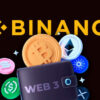
Exploring the Synergy of VR and Blockchain – How Decentralized Platforms are Shaping the Future of Virtual Worlds
Blockchain and virtual reality (VR) are two cutting-edge technologies that create waves in several sectors. With the help of virtual reality (VR) technology, we can now engage with digital information in new ways that are practically identical to reality.
While providing a decentralized, secure, and transparent form of record-keeping and asset exchange, Blockchain technology has upended conventional structures.
There is a growing understanding of the potential synergy between VR and Blockchain as these two technologies develop. Blockchain technology enables the emergence of decentralized VR platforms, which provide new opportunities for building and using virtual worlds.
Blockchain provides actual ownership of virtual assets and value exchange between users by decentralizing virtual worlds, which can significantly influence sectors like gaming, real estate, and education.
This article examines the relationship between VR and Blockchain and the effects of decentralized platforms on the development of virtual worlds.
It will give a general review of both technologies, look at the advantages of combining them, and talk about potential problems and solutions for future advancement. A call to action for more study and development of this fascinating junction of VR and Blockchain will be made at the paper’s conclusion.
Importance of Exploring the Synergy Between VR and Blockchain
Investigating how VR and Blockchain work together is critical for several reasons. First, a variety of businesses, including gaming, real estate, education, and others, have the potential to be transformed by these two technologies.
New opportunities are being generated for both organizations and individuals by fusing VR’s immersive experiences with Blockchain’s decentralized and secure platforms.
There is much room for future innovation and progress because VR and Blockchain integration is still in its infancy. We can better understand how these technologies may interact to produce new value and address issues by investigating the potential of this junction.
The decentralized nature of blockchain technology offers the possibility of finding solutions to several issues facing the VR sector. For instance, users frequently have little influence over the virtual assets they acquire, making the question of virtual asset ownership problematic.
Blockchain may create actual ownership, giving consumers total control over their digital assets and facilitating safe user-to-user transactions.
The exploration of the connections between VR and Blockchain is crucial since it can promote the uptake and development of both technologies. More individuals could be inspired to learn about VR and use Blockchain for value exchange if the potential of decentralized VR platforms is shown, which might help increase these technologies’ reach and influence.
The convergence of VR and Blockchain offers enormous potential for innovation and growth. Investigating this point of intersection is crucial to realize both technologies’ full potential.
Overview of VR and Blockchain
Blockchain and virtual reality (VR) are two cutting-edge technologies that might revolutionize several sectors.
When we talk about virtual reality (VR), we’re talking about a computer-generated simulation of a 3D world that can be interacted with naturally or tangibly. This technology is frequently employed in the entertainment sector, notably in gaming and other industries, including education and healthcare.
On the other hand, Blockchain is a decentralized, secure, and transparent form of value exchange and record-keeping. It uses distributed ledger technology, which is more dependable and secure than conventional centralized systems since it lets different parties access the same data.
Although cryptocurrencies like Bitcoin and Ethereum are frequently linked to blockchain technology, this technology has many uses beyond financial transactions. It is utilized, among other things, in digital identity management, voting systems, and supply chain management.
Several forms of VR, including standalone, PC, and mobile VR, each with unique advantages and restrictions. Similarly, there are many Blockchain architectures, such as public, private, and hybrid, each with a fantastic set of properties that suit various use cases.
In general, VR and Blockchain are two technologies that are reshaping the future of several sectors. Their combination might open new avenues for developing and engaging with virtual worlds.
The Synergy between VR and Blockchain
Developing decentralized VR platforms supported by Blockchain technology is the core of the VR and Blockchain synergy. These tools allow for the genuine ownership of virtual assets and value exchange between users, opening up new possibilities for creating and exploring virtual environments.
The following are some of the main components of the VR and blockchain synergy:
- Decentralized VR Platforms
- Blockchain applications for virtual reality
- VR use cases for Blockchain
Decentralized VR Platforms
Decentralized VR systems are intended to be owned and operated by the user base rather than a single entity. This kind of decentralized network is supported by blockchain technology, which enables safe and open value transfers between users and secure ownership of virtual assets.
Blockchain applications for virtual reality
Actual ownership of virtual assets is now possible thanks to blockchain technology, which has been a significant obstacle for the VR sector. Users that utilize Blockchain may be guaranteed that their virtual assets are safe and cannot be replicated or stolen. Furthermore, Blockchain technology permits secure user-to-user transactions without a central authority or middleman.
VR use cases for Blockchain
Blockchain has several applications in VR, including gaming, virtual homes, and social VR. Blockchain technology may be applied to video games to facilitate in-game transactions, leaderboard creation, and leaderboard security.
Blockchain can be utilized in virtual real estate to establish a decentralized market for buying and selling virtual properties. Blockchain can be applied to social VR for private and secure user communication.
The convergence of VR with Blockchain presents a significant opportunity for development and innovation across several sectors and can fundamentally alter how we create and interact with virtual worlds.
VR and Blockchain Integration’s Potential
The combination of VR with blockchain technology has the potential to open up a variety of new opportunities in several different sectors. The following are some possible advantages of VR with Blockchain integration:
- Secure and Transparent Transactions
- Actual Ownership of Virtual Assets
- Additional User Privacy
- Decentralized VR Platforms
- Innovative Use Cases
Secure and Transparent Transactions
Users in VR settings may deal safely and transparently thanks to the decentralized, secure blockchain technology. This may make it easier to combat theft and fraud in virtual economies and promote more dependable and trustworthy value exchange.
Actual Ownership of Virtual Assets
Actual ownership of virtual goods may be made possible by combining blockchain technology and VR, giving individuals total control over their virtual holdings. Users may also generate additional income by trading or selling virtual goods in a safe and open market.
Additional User Privacy
Blockchain’s decentralized structure can boost privacy in VR settings by letting individuals manage their data and communications with other users. In social VR settings, this can also assist in preventing harassment and abuse.
Decentralized VR Platforms: Blockchain and VR integration may make it possible to build decentralized VR platforms that the user base will own and run. Enabling new revenue sources through token economies and other decentralized apps can give consumers more freedom and autonomy.
Innovative Use Cases
VR and Blockchain integration can open up new and creative use cases in various sectors, including gaming, real estate, education, and more. Blockchain technology, for instance, allows for purchasing and selling virtual properties on a decentralized market.
The combination of VR with Blockchain might, in general, open up a wide range of new options and possibilities and profoundly alter how we build and interact with virtual worlds.
Impact on Industries
Several sectors, including the following, may be significantly impacted by the combination of VR and Blockchain:
- Gaming
- Real estate
- Education
- Healthcare
- Finance
Gaming
The combination of VR and Blockchain is anticipated to have a significant positive impact on the gaming sector. Blockchain technology has the potential to enable safe and open in-game trades while also developing a decentralized market for virtual goods.
Additional money streams for game producers and users might contribute to developing a more vibrant and dynamic virtual economy.
Real estate
The combination of VR and Blockchain can also be advantageous for the real estate sector. Blockchain technology enables a decentralized market for virtual properties, facilitating the buying and selling of virtual real estate. In addition to creating new revenue sources for virtual property owners, this may present new options for real estate developers and investors.
Education
The combination of VR and Blockchain may significantly impact the industry of education. While Blockchain technology enables safe and transparent student information and credentials, VR technology may be leveraged to provide immersive learning experiences. This might contribute to developing a more dependable, transparent, and accountable education system.
Healthcare
VR and Blockchain integration can be advantageous for the healthcare sector. Blockchain technology enables safe and transparent patient records and clinical trial data, while VR technology may be utilized to develop immersive medical simulations and training programs.
This can facilitate better cooperation and creativity in medical research and enhance the standard of care and treatment results.
Finance
The combination of VR and Blockchain may significantly impact the financial sector. Blockchain technology may be used to develop decentralized financial apps and services and safe and transparent value exchange between users. This may create a more open, equal, and user-controlled financial system.
The fusion of VR with Blockchain has the potential to open up new avenues and possibilities in a variety of fields. It might fundamentally alter how we build and interact with virtual worlds.
Conclusion
With new opportunities and possibilities across many sectors, the combination of VR with Blockchain technology has the potential to alter how we develop and enjoy virtual worlds.
The symbiotic relationship between VR and Blockchain can lead to creative use cases, decentralized VR platforms, genuine ownership of virtual assets, improved user privacy, and safe and transparent transactions.
Among the sectors that potentially gain from this integration are the gaming sector, real estate, education, healthcare, and finance, with new income sources, increased efficiency, transparency, and accountability.
We anticipate seeing even more cutting-edge applications and use cases emerge as VR and Blockchain continue to develop and expand, fostering higher levels of interaction, innovation, and value generation in virtual environments.





